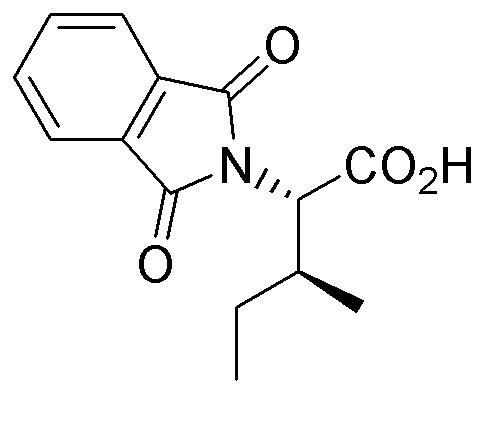Phthaloyl-L-isoleucine is widely utilized in research focused on:
- Peptide Synthesis: This compound serves as a valuable building block in the synthesis of peptides, enhancing the efficiency of creating complex molecules for pharmaceutical applications.
- Drug Development: It plays a crucial role in the development of new drugs, particularly in the design of peptide-based therapeutics that target specific biological pathways.
- Biochemical Research: Researchers use it to study protein interactions and enzyme activities, providing insights into cellular mechanisms and potential therapeutic targets.
- Cosmetic Formulations: Its properties make it suitable for use in cosmetic products, where it can improve skin absorption and enhance product efficacy.
- Food Industry: The compound is explored for its potential applications in food technology, particularly in flavor enhancement and preservation, contributing to improved food quality.
General Information
Properties
Safety and Regulations
Applications
Phthaloyl-L-isoleucine is widely utilized in research focused on:
- Peptide Synthesis: This compound serves as a valuable building block in the synthesis of peptides, enhancing the efficiency of creating complex molecules for pharmaceutical applications.
- Drug Development: It plays a crucial role in the development of new drugs, particularly in the design of peptide-based therapeutics that target specific biological pathways.
- Biochemical Research: Researchers use it to study protein interactions and enzyme activities, providing insights into cellular mechanisms and potential therapeutic targets.
- Cosmetic Formulations: Its properties make it suitable for use in cosmetic products, where it can improve skin absorption and enhance product efficacy.
- Food Industry: The compound is explored for its potential applications in food technology, particularly in flavor enhancement and preservation, contributing to improved food quality.
Documents
Safety Data Sheets (SDS)
The SDS provides comprehensive safety information on handling, storage, and disposal of the product.
Product Specification (PS)
The PS provides a comprehensive breakdown of the product’s properties, including chemical composition, physical state, purity, and storage requirements. It also details acceptable quality ranges and the product's intended applications.
Certificates of Analysis (COA)
Search for Certificates of Analysis (COA) by entering the products Lot Number. Lot and Batch Numbers can be found on a product’s label following the words ‘Lot’ or ‘Batch’.
*Catalog Number
*Lot Number
Certificates Of Origin (COO)
This COO confirms the country where the product was manufactured, and also details the materials and components used in it and whether it is derived from natural, synthetic, or other specific sources. This certificate may be required for customs, trade, and regulatory compliance.
*Catalog Number
*Lot Number
Safety Data Sheets (SDS)
The SDS provides comprehensive safety information on handling, storage, and disposal of the product.
DownloadProduct Specification (PS)
The PS provides a comprehensive breakdown of the product’s properties, including chemical composition, physical state, purity, and storage requirements. It also details acceptable quality ranges and the product's intended applications.
DownloadCertificates of Analysis (COA)
Search for Certificates of Analysis (COA) by entering the products Lot Number. Lot and Batch Numbers can be found on a product’s label following the words ‘Lot’ or ‘Batch’.
*Catalog Number
*Lot Number
Certificates Of Origin (COO)
This COO confirms the country where the product was manufactured, and also details the materials and components used in it and whether it is derived from natural, synthetic, or other specific sources. This certificate may be required for customs, trade, and regulatory compliance.


